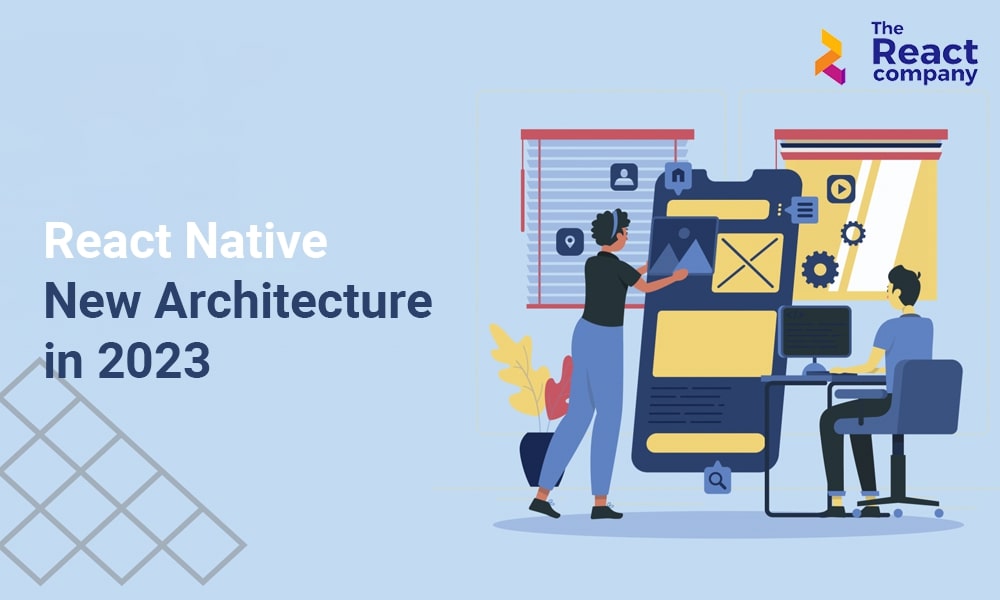React Native has been a popular framework for mobile app development, offering a powerful solution for building cross-platform applications with JavaScript. As we step into 2023, React Native has undergone significant changes in its architecture, bringing about improvements and new features. In this blog, we will delve into the advancements in React Native architecture, explore the benefits it offers to React experts and React app development and gain a deeper understanding of the framework’s evolution.
Benefits of React Native New Architecture
The new architecture of React Native brings forth several benefits that enhance the development experience and enable the creation of high-quality, cross-platform applications. Here are some key benefits of React Native new architecture:
1. Improved Performance:
The new architecture introduces performance optimizations, resulting in faster startup times, reduced memory usage, and smoother animations. These improvements enhance the overall performance of React Native applications, providing a seamless and responsive user experience.
2. Enhanced Developer Tools:
React Native new architecture includes enhanced developer tools and debugging capabilities. Developers can leverage features like improved error handling, hot reloading, and advanced debugging tools to streamline their development process, identify and fix issues efficiently, and iterate on their code more effectively.
3. Seamless Integration with Native Modules and APIs:
React Native new architecture offers better integration with native modules and APIs. Developers can seamlessly access platform-specific features and functionalities, allowing for the creation of more feature-rich and powerful applications. This integration opens up a world of possibilities for leveraging device-specific capabilities and delivering native-like experiences.
4. Code Reusability:
React Native modular and component-based architecture enables code reusability across different platforms. Developers can write a single codebase and deploy it on both iOS and Android platforms, saving time and effort. This code-sharing capability streamlines the development process, reduces duplication of work, and ensures consistency across multiple platforms.
5. Cross-Platform Development:
The new architecture of React Native further solidifies its position as a leading framework for cross-platform development. With React Native, developers can build applications that work seamlessly on both iOS and Android devices, eliminating the need to develop separate codebases for each platform. This cross-platform capability significantly reduces development time and costs while enabling a broader audience reach.
6. Community and Ecosystem Support:
React Native app development has a thriving community and a vast ecosystem of libraries, tools, and resources. The new architecture of React Native aligns with the latest trends and advancements, ensuring ongoing support and continuous improvement from the community. Developers can leverage this robust ecosystem to accelerate development, access ready-to-use components, and benefit from the collective knowledge and expertise of the React Native community.
By harnessing the benefits of React Native new architecture, developers can create high-performance, feature-rich, and cross-platform applications efficiently. These advancements contribute to an improved development experience, a faster time-to-market, and the ability to deliver exceptional user experiences on multiple platforms.
React Native New Architecture
1. The Evolving Architecture of React Native
React Native’s architecture has evolved to address several key challenges faced by developers. The new architecture focuses on enhancing performance, increasing code reusability, and providing a more native-like experience for mobile applications. With improvements in core components, navigation, and rendering, React Native has become more efficient and capable of delivering high-quality user experiences.
2. Leveraging React Native New Features for React Experts
React experts can leverage the new features and improvements in React Native architecture to enhance their development workflow and productivity. With a more streamlined development process, React experts can take advantage of the modular and component-based nature of React Native, allowing for code reuse across multiple platforms. This will explore how React experts can harness React Native new architecture to build robust, scalable, and performant applications.
3. React App Development with React Native
The new architecture of React Native brings several benefits to React app development. Developers can now enjoy improved hot-reloading capabilities, faster build times, and smoother debugging experiences. The new architecture also provides better integration with native modules and APIs, enabling developers to access platform-specific features and functionality seamlessly. This will highlight the advantages that React app developers can expect when utilizing React Native new architecture in 2023.
4. Empowering Cross-Platform Development and Beyond
React Native new architecture further strengthens its position as a leading framework for cross-platform development. With its ability to share a significant portion of code between iOS and Android platforms, React Native enables developers to build applications more efficiently, saving time and effort. Additionally, React Native’s architecture opens up possibilities for extending its reach beyond mobile platforms, such as desktop and web applications. This subtitle will explore how React Native’s new architecture empowers developers to create versatile applications across various platforms.
5. React Native Architecture Evolution: A Deep Dive
This subtitle will provide a comprehensive overview of the changes and enhancements made to React Native’s architecture in 2023. It will explore the technical aspects of the architecture evolution, including updates to the core engine, improvements in bridge communication, and optimizations in the rendering pipeline. By diving into the details, readers will gain a deeper understanding of how React Native’s architecture has evolved to meet the demands of modern app development.
6. Performance Boost: Optimizing React Native New Architecture
Performance is a critical aspect of mobile app development, and React Native’s new architecture aims to deliver enhanced performance for applications. This subtitle will explore the performance optimizations introduced in the new architecture, such as improved startup times, a reduced memory footprint, and smoother animations. It will highlight the impact of these optimizations on app performance and the benefits they bring to developers and end-users.
7. Enhanced Developer Tools and Debugging Capabilities
Developers rely on robust tools and debugging capabilities to streamline their development process and troubleshoot issues effectively. This subtitle will discuss the new developer tools and debugging capabilities introduced in React Native’s new architecture. It will cover features such as improved error handling, enhanced hot reloading, and advanced debugging tools. By leveraging these tools, React developers can work more efficiently and deliver high-quality apps.
8. Integrating Native Modules and APIs: Expanding Possibilities
React Native’s new architecture provides improved integration with native modules and APIs, enabling developers to access platform-specific features seamlessly. This subtitle will explore the expanded possibilities that come with the integration of native modules, such as accessing device functionalities, leveraging platform-specific UI components, and utilizing native libraries of React. It will highlight how this integration opens doors to creating more powerful and feature-rich applications.
9. Future Prospects: React Native’s Architecture Beyond Mobile
While React Native has primarily been used for mobile app development, its new architecture presents opportunities to extend its reach beyond mobile platforms. This subtitle will discuss the potential for utilizing React Native for desktop and web application development. It will explore frameworks like React Native for Windows and React Native Web and how the new architecture supports building cross-platform applications across diverse environments.
Conclusion
As React Native architecture evolves in 2023, developers and React experts can leverage its new features and enhancements to build high-performance, cross-platform applications. With optimizations for performance, enhanced developer tools, improved integration with native modules, and the potential for expanding beyond mobile platforms, React Native architecture opens doors to exciting possibilities. By embracing these advancements, developers can unlock their full potential and deliver exceptional user experiences across various devices and platforms.



